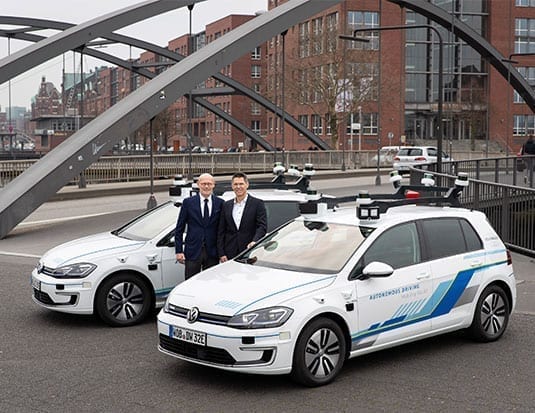Volkswagen Group Research has begun testing a fleet of five automated e-Golf vehicles in urban traffic in Hamburg, Germany.
A fleet of five automated e-Golf vehicles, equipped with eleven laser scanners, 14 cameras, ultrasonic sensors, and seven radars, will drive on a three-kilometer section of the digital test bed for automated and connected Level 4 driving in the Hanseatic city. The vehicles can share five gigabytes of data per minute and last several hours.
Currently, another 9-kilometer digital test bed for automated and connected driving is being constructed in the city with its completion scheduled for 2020. To accomplish this, the Free and Hanseatic City of Hamburg is also upgrading traffic lights with components for infrastructure-to-vehicle and vehicle-to-infrastructure communication. By optimizing traffic flows through digitization, full-size implementation of automated driving could be possible shortly.
Axel Heinrich, Head of Volkswagen Group Research, commented: “The tests center on technical possibilities as well as urban infrastructure requirements. In order to make driving even safer and more comfortable in future, vehicles not only have to become autonomous and more intelligent – cities must also provide a digital ecosystem that enables vehicles to communicate with traffic lights and traffic management systems as well as with one another.”
Additionally, one e-Golf will have the computing power of about 15 laptops tucked away in the trunk of the car. The high computing capacity and the sensors feed the car data on pedestrians, cyclists, other vehicles, intersections, rights of way, parked vehicles and lane changes in moving traffic, which are captured over the shortest distances and in milliseconds. By using deep learning, neural networks, and pattern recognition, the onboard artificial intelligence software will register relevant objects and respond to them accordingly.
For safety reasons, specially trained test drivers will then be seated behind the steering wheel at all times to monitor the driving functions and intervene when there is a chance an accident may occur. Furthermore, all data protection rules will be fully taken into account.
Michael Westhagemann, Hamburg’s Senator for Economics, Transport and Innovation, said: “Two and a half years from now, Hamburg will be hosting the World Congress for Intelligent Transport Systems (ITS). Automated driving will play a key role. I am delighted that our strategic partner Volkswagen has already become the first user for our digital test bed. We will establish Hamburg as a model city for intelligent mobility and be presenting numerous innovative mobility projects to a global audience in 2021.”
Overall, there are five different levels of automated driving:
- Level 1: Assisted driving. Example, Adaptive Cruise Control (ACC);
- Level 2: Partial automation. Example, Travel Assist (combination of adaptive cruise control and lane-keep assist);
- Level 3: Conditional automation. Example, Traffic Jam Assist;
- Level 4: High Automation. Example, Park Pilot; and
- Level 5: Full automation. Example, fully self-driving transport.
Volkswagen Group Research is collaborating with all brands and relevant Group departments to enable functionality of automated driving on public roads with Level 5 vehicles. The results of the tests will be directly incorporated into more tests, research and developments for the Group.
The goal of the Group is to offer customer concrete products for the transport of goods and passenger on public roads using autonomous vehicles in hopes that this will improve traffic flow and road safety over time. However, automated driving without a safety driver in public traffic requires changes in the legislative framework and the availability of the necessary infrastructure.



